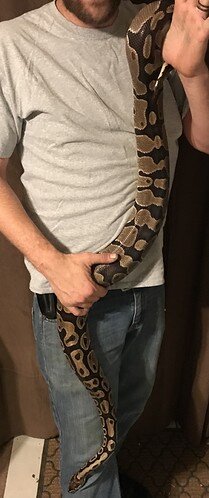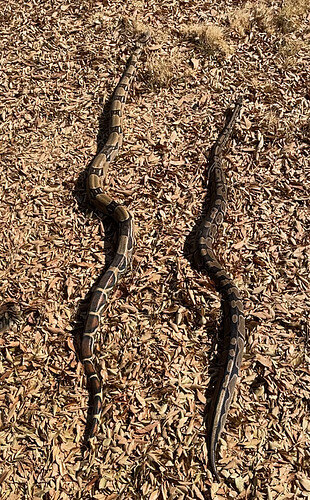Exactly! I would quit if I had to weigh 140 rats every feeding lol.
I’ll preface this by saying, for the first two years I bred, I kept all my females between solidly overweight and obese.
First I would suggest, don’t change anything that you’re doing if you want this female to breed this season. Building a clutch and dropping it will cut weight off of her without you having to do it through food conditioning. From here you can just feed her one rat a week until she ovulates if you want but don’t change the feeding frequency or she might back off.
After weighing a bunch of rats, my suggestion would be to feed her two of the 90g rats about 14 days apart and see if she maintains a little tighter physique. That picture may be a little deceiving regarding her size, if she’s currently digesting. She looks a little bloated which is normal during digestion (they don’t pass gas efficiently).
I rarely feed more frequently than 10 days apart and most of my females right at 14 days. It’s not a set in stone schedule though. Feeding breeders is a little more complex than maintaining healthy weight in pets.
You do have to ‘feed to breed’ a little bit. I’ve honed it down to literally 3-5 extra rats a year, through practice. You’re just trying to trick a biological response. All you need is a food surplus to do that, but there are multiple methods that accomplish the same goal.
It doesn’t have to be a scientific endeavor. Think of feeding like the accelerator pedal in your car, get on the gas a little bit when you see building behavior and want them to produce, coast more if you see her looking chunky.
The wildcard with feeding is metabolic efficiency. I hold back whole clutches sometimes and if you do that you’ll see that feeding them exactly the same their physiques will diverge just like any animal. I have some females that will get chubby even on my conservative feeding schedule. That’s where the accelerator pedal analogy comes in.
I use this female as an example all the time because of her sheer size. Even on my feeding schedule she’s a little heavier than she needs to be here. In breeding condition she’s about 43-4400g. She gets about 15-18 small rats a year (probably 130-150g meals). She lays 10-12 eggs every year she goes. This picture is a couple weeks before she ovulated so she’s at her maximum size here. Keep in mind this is a genetically large female and she’s truly mature (10 years old) so her body is a lot wider than anything most BP keepers have seen, but she gets back to this body condition on less than 20 meals a year. That’s about 30 less rats per year than most breeders are feeding. The biggest advantage I’ve noticed keeping them leaner is that they recover bodyweight faster after they lay giving me the option to fast them for a month or two if time allows. Very few environments have food availability all year long, so most species have evolved with seasonal fasting being the norm and I like to play at replicating it.






 she’s beautiful
she’s beautiful 


